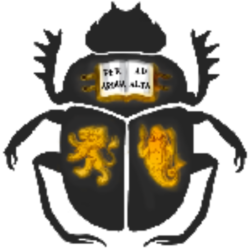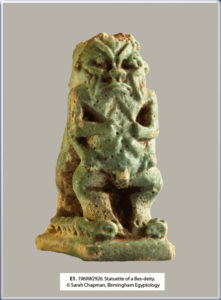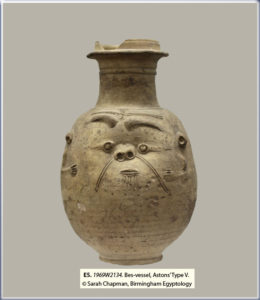Click the images to enlarge
——————————————————————————————————————————————————————————-
E. Object Labels (pdf file)
Click here for a 3D pdf model of E1. 1969W2926 (pdf file)
Click here for a 3D pdf model of E2. 1969W655 (pdf file)
A particularly unusual image that appears during the Late Period is one in which a combination of iconography is applied and which Andrews has termed a version of the ‘cippus’ (Andrews 1994: 37-38), whilst Dasen terms them ‘pantheos’ figures (Dasen 1993: 65-66). Andrews elaborates that these ‘monstrous’ forms represented ‘divine power’ and were ‘capable of overwhelming any menacing opposing forces, whether human or divine, in this world or the next’ (Andrews 1994: 38). Two such amulets may exhibit these characteristics, 1969W2926 and 1969W655. The first shows a Bes-deity or, according to Andrews a ‘naked figure wearing a Bes mask’, with closed wings stretched behind. Wings first appeared in New Kingdom amulets of ‘Bes’ and here exhibit a further development of this iconography. The figure stands on a plinth encircled by snakes, while holding more creatures in his two pairs of hands. On the underside of the plinth is a depiction of further fierce animals, such as snakes, scorpions and jackals. In place of the figure’s genitals is another animal head, possibly a lion. Damage indicates that there was some form of headdress which is now lost, as is the suspension loop that should be behind the head. 1969W655 exhibits similar characteristics to the other, although on this figure there are multiple pairs of wings, including the two closed at the rear and another two pairs open at each side of the body.

Again, two pairs of arms are shown and in this instance the figure holds a was sceptre in one of his left hands. The face of the Bes-image has a protruding tongue, and is topped by the horns of a now lost headdress. On either side of the figure’s face are the protruding faces of other animals, a monkey being the most recognisable. The genitals, and even the kneecaps and feet of the deity have been replaced with animal heads including lions and jackals. Once again the plinth is surrounded by a snake, in this instance one that is eating its own tail (ouroboros), and other fierce animals in procession. Dasen argues that these figures represent the Bes-deity becoming a ‘compound figure built up with attributes of several gods’ (Dasen 1993: 65). She continues that the image is that of a primordial creator god, particularly that of Amun-Re with various features linking the image to this deity, such as rams horns and sun disks (Dasen 1993: 66). On the other hand, Andrews postulates that these objects probably reflect the growing connection between the Bes-deities and Horus, particularly Horus-the-Child (the later Harpocrates), possibly into the composite deity of Hor-Bes. They could therefore be viewed as precursors for the stone cippi that represent the face of the Bes-image over that of the young Horus-the-Child in the marshes, as can be seen in 1969W3078. This object is a fragment of limestone cippus and clearly shows a large Bes-head, with lion ears and long beard and moustache (or mane), over the head of Horus-the-Child, to the right of which is the top of a scorpion. These objects were utilised in water rituals, when the liquid was poured over them and subsequently drank to engender the worshipper with prophylactic power and protect them from dangerous animals (Andrews 1994: 39). Both theories assist in emphasising that this development represents a significant change in the perception of the Bes-deities and their role in Egyptian religion.

Two ‘Bes’-vessels in the collection of Birmingham Museum and Art Gallery exemplify the increasing popularity of the Bes-image and its transference to different material objects. 1969W2133 represents Aston and Aston’s Type III, and consists of a Nile silt, bag-shaped vessel with rounded base and a rolled, flaring rim. The facial features of the Bes-image have been crudely applied using rolls of clay. According to Aston and Aston this type of vessel should be dated to the Twenty-Sixth Dynasty (Aston and Aston 2003: 100); unfortunately no provenance is known for this object. 1969W2134 certainly reflects Aston and Aston’s Type V. It is made of Marl A2 or A3, and represents a necked vessel with ovoid body and clearly marked shoulder, the rim is flanged, and two ‘collar’ ridges can be seen on the neck. A vertical handle extends from the rim to the shoulder of the vessel and the well-defined facial features can be clearly seen. Two small arms extend from the ears on the sides of the vessel (when viewed frontally), and a moustache and beard have been incised around the mouth of the face. Above the eyebrows are a series of possible frown lines, or perhaps a stylised plumed headdress with sun disk. Aston and Aston indicate that type V Bes vases are part of a Memphite/Faiyum (Lower Egyptian) tradition of pottery manufacture during the Twenty-Seventh Dynasty (Aston and Aston 2003: 106). It is clear from objects introduced during the Late Period that the iconography of the Bes-image experiences significant changes, which likely reflect the influence of foreign cultures, from the New Kingdom, on Egypt’s religious imagery and also the subsequent syncretism that the Bes-deities had with state gods.
Back Home Next









